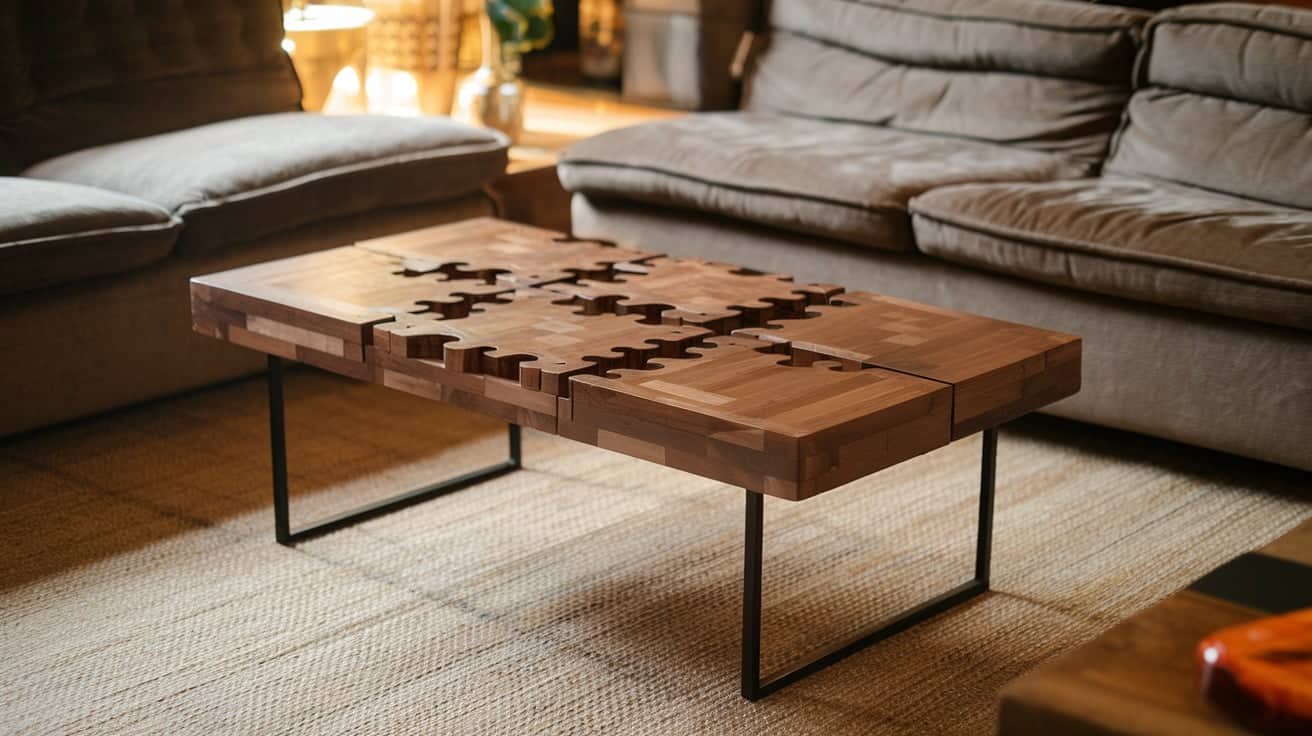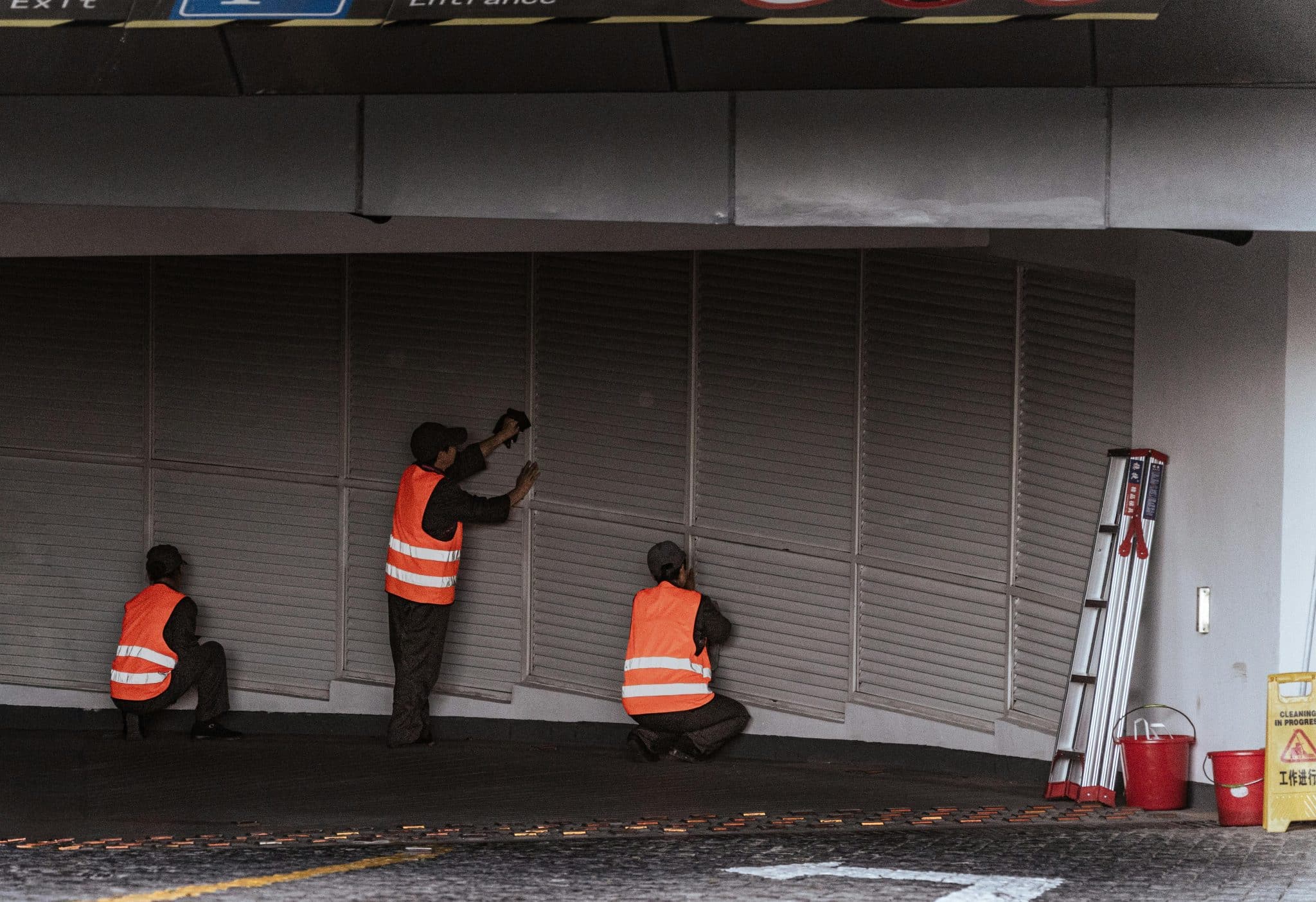Have you ever found yourself halfway through a puzzle only to need your coffee table space for dinner? I’ve been there. Trying to preserve an unfinished puzzle while reclaiming your living room can feel like an impossible task.
Sliding puzzles onto cardboard or clearing them away completely often leads to lost pieces and frustration.
That’s why I built this specialized coffee table with hidden puzzle storage. It’s designed to keep your puzzles safe and intact until you’re ready to continue working on them.
In this direction, I’ll show you how to create your puzzle coffee table using basic woodworking tools and materials. You’ll learn each step of the process, from cutting the frame pieces to applying the final finish.
What Makes a Puzzle Coffee Table So Special?
A puzzle coffee table is a clever piece of furniture with a top that lifts off or slides away to reveal hidden storage inside. Think of it as a coffee table with a secret!
Why build one? First, it’s incredibly practical to store remotes, magazines, and game controllers out of sight but within reach. Second, it becomes an instant conversation piece when guests visit and discover its hidden compartment.
Building one yourself means you can customize everything, the wood type, size, and finish to match your space perfectly. Plus, there’s nothing quite like the pride of pointing to a beautiful piece of furniture and saying, “I made that!”
Even with basic woodworking skills, you can create something that’s both functional and impressive.
Tools Used to Make a Puzzle Coffee Table
| Tool | Purpose |
|---|---|
| Table saw | For cutting large pieces of wood |
| Miter saw | For making precise angle cuts |
| Router with lift table (installed in workbench) | For shaping edges and grooves |
| 3/4″ flat router bit | For smoothing and shaping edges |
| Planer | For leveling and smoothing surfaces |
| Jointer | For flattening and straightening wood |
| Biscuit jointer | For joining pieces of wood together |
| Track saw | For straight and accurate cuts |
| Clamps | For holding wood pieces together during assembly |
| Drill/driver | For drilling holes and driving screws |
| Sander | For smoothing surfaces |
| Tape measure | For accurate measurements |
| Pencil/marker | For marking measurements and cuts |
| Saw horses | For supporting wood during cutting |
Materials Used to Make a Puzzle Coffee Table
| Material | Purpose |
|---|---|
| 3/4″ Walnut boards | For the frame sides and the top of the table |
| 3/4″ Maple veneer plywood | For the bottom panel of the table |
| Wood glue | For bonding wood pieces together |
| Small panel nails | For securing wood pieces |
| Biscuits for joining wood | For aligning and joining wood pieces |
| Decorative metal base | For supporting the table and aesthetic appeal |
| 3/4″ lag screws and washers | For assembling and securing the frame |
| Linseed oil | For wood conditioning and finishing |
| Polyurethane | Sealing and protecting the wood |
| Mineral spirits | For thinning the finish and cleaning the tools |
| Two-part oil/hardener finish | For the final protective coating |
Easy Guide to Creating a Puzzle Coffee Table
This step-by-step woodworking guide will help beginners and skilled crafters rework raw lumber into a stunning puzzle coffee table.
Step 1: Building the Frame and Preparing Materials
Begin by cutting 3/4″ walnut into 3″ wide strips: two pieces at 34″ for the sides and two at 22″ for the ends. Make 45-degree miter cuts at all ends to create seamless corners.
Using a router with a 1/4″ flat bit, carve 1/4″ deep grooves along the edges to hold the bottom panel securely. Cut a 33″ x 21″ maple plywood panel for the base.
Before proceeding with the final assembly, test-fit all parts to ensure everything aligns correctly.
Pro Tip: Test your miter cuts on scrap wood first to ensure perfect corners.
Common Mistake: Inconsistent router height creates uneven grooves that affect panel fit.
Step 2: Assembling the Box and Bottom
Apply wood glue to all grooves and carefully insert the plywood bottom into the frame. Secure the corners with small panel nails, making sure the joints are tight and gap-free.
Next, apply glue to the corner joints and use clamps to hold the entire assembly together. Ensure the corners remain square while the glue dries.
Allow the assembly to set completely before proceeding to the next step for a sturdy and secure base.
Pro Tip: Have all clamps ready before starting the glue-up process.
Common Mistake: Insufficient clamping pressure can result in gaps and a box that isn’t square.
Step 3: Creating and Joining the Top
Select walnut boards for the top, plane them smooth, and joint the edges. Create biscuit joints along the seams, apply wood glue, and clamp the pieces together securely.
Once the glue has dried, trim the top to the final dimensions of 24″ x 36″ using a track saw or circular saw with a guide for straight, precise cuts. Allow the top to set before moving on to the finishing touches.
Pro Tip: Alternate growth ring direction between boards to minimize warping.
Common Mistake: Working too slowly with glue can cause biscuits to expand prematurely.
Step 4: Adding Alignment Blocks and Finishing Surfaces
Install small alignment blocks 1-7/8″ from each corner on the underside of the table’s top to ensure proper alignment during assembly.
Pro Tip: Use the same wood for alignment blocks for a cohesive look.
Common Mistake: Positioning blocks incorrectly allows too much movement of the top.
Step 5: Applying Base Finish
To create the finish, mix equal parts linseed oil, polyurethane, and mineral spirits. Apply the mixture generously to all surfaces, allowing it to penetrate for about 15 minutes.
Afterward, wipe off any excess. Let each coat dry fully before applying additional layers. Repeat the process until the desired finish is achieved, ensuring smooth coverage and protection for the wood.
Pro Tip: Mix only what you need for each application session.
Common Mistake: Applying finish in direct sunlight or high humidity affects drying quality.
Step 6: Attaching Base and Final Finishing
Center the metal base and attach it to the table using pre-drilled holes and lag screws. For the final coat, apply a two-part oil hardener finish evenly using a squeegee.
Rub it in thoroughly and buff the surface after a few minutes for a smooth, glossy finish. Allow the finish to dry completely before handling the table, ensuring durability and a professional-quality appearance.
Pro Tip: Apply paste wax to screws before driving to prevent wood splitting.
Common Mistake: Not following exact mixing ratios for the final finish can prevent proper curing.
Special thanks to Cardinal Creek Woodcrafts for providing valuable insights in their video, which I referenced while creating this guide.
Keeping Your Coffee Table Beautiful
Let’s talk about how to keep your new coffee table looking as awesome as the day you built it! After putting in all that work to create something special, you’ll want it to last.
Simple Care That Makes a Big Difference
- Dust is your table’s enemy number one. I wipe mine down once a week with a soft, slightly damp cloth. No fancy cleaners are needed; just water does the trick for regular cleaning.
- For tougher spots, a tiny bit of mild dish soap mixed with water works wonders, but always wipe it dry afterward.
- Spills happen (especially during game night!), so I keep a soft cloth nearby to blot up any accidents quickly. The quicker you catch a spill, the less chance it has to seep into the wood.
Protecting Your Table’s Good Looks
- Those gorgeous wood surfaces need some TLC every few months. I apply a furniture polish or wax specifically made for the type of wood I used.
- Coasters aren’t just for fancy houses; they’re your table’s best friend! I keep a stack right on the table to encourage everyone to use them.
- For the puzzle storage area, I occasionally vacuum out any dust or puzzle piece fragments that might collect inside.
Conclusion
Building this coffee table has changed my puzzling experience completely. No more scrambling to clear the table for dinner or losing pieces when moving a half-finished masterpiece!
What I love most about this project is how practical it is to store puzzles safely until you’re ready to continue. Then, lift the top and resume where you left off. Additionally, you’ll have a beautiful, handcrafted piece of furniture that serves as a conversation starter.
Even if you’re new to woodworking, the steps are straightforward enough to follow. Take your time, enjoy the process, and soon you’ll have a custom table that serves both form and function.
Ready to save your puzzles and your sanity? Grab those tools and get started. Your future self will thank you!
Frequently Asked Questions
1. Can I Use This Table Design for Other Board Games Besides Puzzles?
Yes! While designed with puzzles in mind, this table works wonderfully for board games, card games, or any tabletop activity you want to pause and resume later.
2. Is There a Way to Add a Locking Mechanism to Secure the Top?
Though the instructions do not cover this, you can add magnetic catches or small, recessed latches to secure the top. This is especially useful if you have pets or small children.
3. Do I Need All the Specialized Tools Listed, or Are There Alternatives?
While the specialized tools make the job easier, you can complete this project with basic tools. A circular saw with a straight edge can replace the track saw, and you can use dowels instead of biscuit joints.














